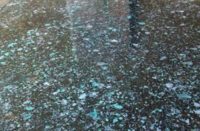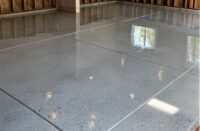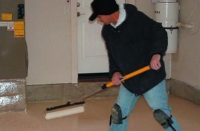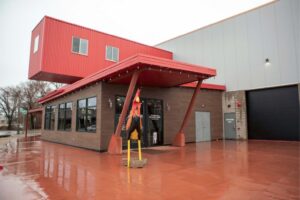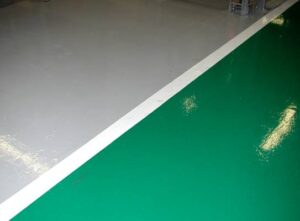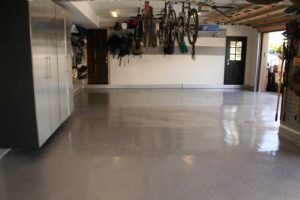For decorative concrete artisans, an exciting new direction for polyaspartic coatings is countertops and sinks. One contractor, Dave Paterson of Desert Canyon Epoxy Floor Coatings, based in Scottsdale, Ariz., has elevated the technique he uses for commercial floors to counter level. He uses a prism-flake vinyl chip in the mid-coat to add sparkle and create counters that look like granite.
Of course, a counter is different from a floor. Paterson adds a lot more chips to his counters. “Flood the chips to the point of refusal,” he says, “then clean off the excess and apply multiple topcoats.” Paterson also likes to add more topcoats to counters to get the surface shinier and smoother. He uses Advacoat polyaspartic coatings.
Chris Klipfel, owner of CK Concrete Design, in St. Louis, Mo., uses clear polyaspartic coatings with no chips to protect the beauty of colored concrete in sinks and countertops. He says they are ideal for commercial bar tops. “These are high-use settings, serving many people for many hours at a time,” he explains. “They are exposed to a high number of acids — wine, lemons, limes — and are almost always wet. Polyaspartics protect concrete from all that.”
 He demands a high-quality formulation. “Counters are much closer to the customers’ face than floors are. Failures and flaws are obvious.”
He demands a high-quality formulation. “Counters are much closer to the customers’ face than floors are. Failures and flaws are obvious.”
For precast counters, Klipfel often applies the material in a spray booth using a high-velocity lowpressure spray gun to eliminate roller marks. He uses glossy, matte and satin coatings from Flexmar Coatings.
Doug Bannister, founder of The Stamp Store and One Day Floors, first started using his company’s polyaspartics on outdoor countertops because he wanted higher UV stability than other coatings offered. He has since taken the materials to new artistic heights, most recently creating two concrete tabletops sold to raise money for Native American art galleries. He created these unique pieces by applying the polyaspartic, buffing it with a buffer like those used to wax cars, sanding with wet sandpaper, then applying a heavy-cut rubbing compound and finally a fine-cut rubbing compound. The result is a waxy, smooth, softlooking surface.
All the properties that make polyaspartics attractive for commercial floors — stain resistance, UV stability, abrasion resistance, fast cure — make them even more attractive for countertops. At the same time, the application challenges are magnified. “Counters are under close visual scrutiny,” Klipfel says. “You have to have a smooth finish. It’s two feet away from your face!”
